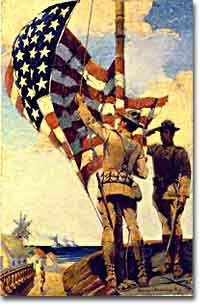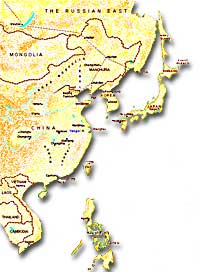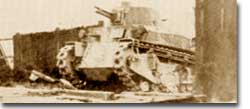50a. 1930s Isolationism

Franklin D. Roosevelt's "Good Neighbor Policy" was instituted to foster good relations from other countries within the same hemisphere. As a result, Marines stationed in the Caribbean — like those seen here — were withdrawn.
"Leave me alone," seemed to be America's attitude toward the rest of the world in the 1930s.
At the dawn of the '30s, foreign policy was not a burning issue for the average American. The stock market had just crashed and each passing month brought greater and greater hardships. American involvement with Europe had brought war in 1917 and unpaid debt throughout the 1920s. Having grown weary with the course of world events, citizens were convinced the most important issues to be tackled were domestic. Foreign policy leaders of the 1930s once again led the country down its well-traveled path of isolationism.
The Hoover Administration set the tone for an isolationist foreign policy with the Hawley-Smoot Tariff. Trade often dominated international relations and the protective wall of the tariff left little to discuss. The Far East became an area of concern when the Japanese government ordered an attack on Chinese Manchuria. This invasion was a clear violation of the Nine Power Treaty, which prohibited nations from carving a special sphere of influence in China.

Political boundaries in East Asia, seen here at the turn of the century, were increasingly challenged in the years leading up to World War II.
The Hoover Administration knew that any harsh action against Japan would be unpopular in the midst of the Great Depression. The official American response was the Stimson Doctrine, which refused to recognize any territory illegally occupied by Japan. As meek as this may sound, it went further toward condemning Japan than the government of Great Britain was willing to do.
One possibility for international economic cooperation failed at the London Conference of 1933. Leaders of European nations hoped to increase trade and stabilize international currencies. Roosevelt sent a "bombshell message" to the conference refusing any attempt to tie the American dollar to a gold standard. The conference dissolved with European delegates miffed at the lack of cooperation by the United States.
Roosevelt did realize that the Hawley-Smoot Tariff was forestalling American economic recovery. Toward this end, Congress did act to make United States trade policy more flexible. Under the Reciprocal Trade Agreement of 1934, Congress authorized the President to negotiate tariff rates with individual nations. Should a nation agree to reduce its barriers to trade with the United States, the President could reciprocate without the consent of Congress. In addition, FDR broke a 16-year-old diplomatic freeze with the Soviet Union by extending formal recognition. Roosevelt hoped to settle some nettlesome outstanding issues with the Soviets, and at the same time stimulate bilateral trade.

The Japanese attack on Chinese Manchuria was in direct violation of the Nine Powers Treaty, which had been passed to prevent nations from establishing a special sphere of influence in China. Here a Japanese tank rolls through Shanghai, China.
Isolationists did not however designate the Western Hemisphere as a dangerous region. On the contrary, as tensions grew in Europe and Asia, a strong sense of Pan-Americanism swept the diplomatic circles. In the face of overseas adversity, strong hemispheric solidarity was attractive. To foster better relations with the nations to the south, Roosevelt declared a bold new Good Neighbor Policy. Marines stationed in Central America and the Caribbean were withdrawn. The (Theodore) Roosevelt Corollary, which proclaimed the right of the United States to intervene in Latin American affairs was renounced.
The United States would soon been intervening in something much bigger.






